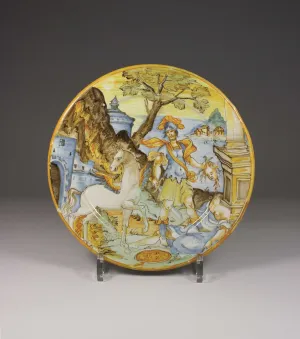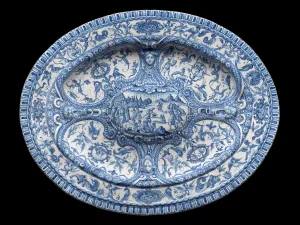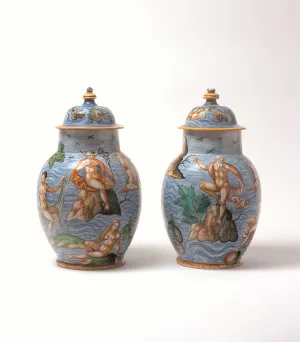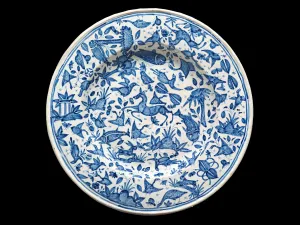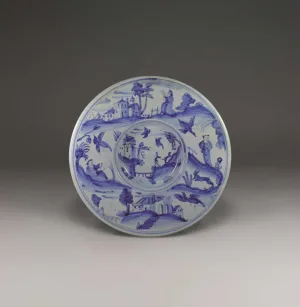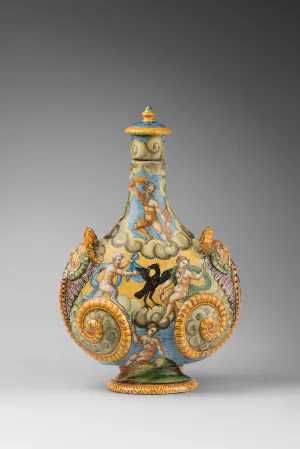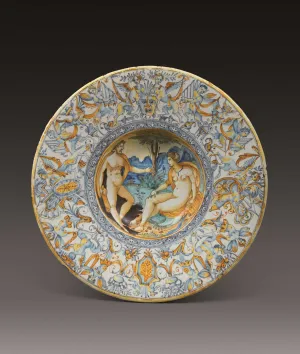Nevers: The Birth of French Faience
In the late sixteenth century, numerous Italian artists and craftsmen moved to Nevers, a city ruled by an Italian prince, Luigi Gonzaga of Mantua, since his marriage in 1565 to Henriette of Cleves, Duchess of Nevers. Among them was Augustin Conrade, a maiolica potter from Albissola, in Liguria, whose family went on to dominate the production of faience in Nevers until the mid-seventeenth century. From 1626 until his death in 1647, his great nephew Antoine Conrade became the head of Les Trois Mores (The Three Moors), the largest workshop in Nevers, where most of the pieces in this case were made, including two signed pieces (cats. 13, 14).
To satisfy a clientele passionate about Italian art, Antoine Conrade’s workshop continued to produce Italian-style Renaissance maiolica with istoriato and grotesque decoration until the middle of the seventeenth century (cats. 7, 8, 12). In some cases, they painted colorful scenes onto shapes and forms not used by Italian potters, as on a pair of covered jars after a traditional Chinese form (cat. 12). In other instances, as in the spectacular dish (cat. 8), they used Italian models from Urbino for the complex shape of the vessel and the grotesque decoration. Like most of the pieces made in Nevers in the early seventeenth century, this dish was until recently considered to be a great example of Italian Renaissance maiolica, although monochrome blue was mainly produced in Nevers and never in Urbino.
Monochrome blue was first developed in Savona (in the region of Liguria, Italy), but it became a Nevers specialty. Several of the pieces shown in the exhibition were influenced by the blue-and-white production of Savona, some depicting small figures dressed in Chinese costumes set in Asian-style landscapes (cat. 14, 15). A rare example of this type is the large plate with fish, birds, and other animals painted on the surface to cover as much white ground as possible without overlap, following a decorative style from Persia (cat. 13).
Plate
Nevers, 1635
Attributed to Denis Lefebvre
Faience (tin-glazed earthenware)
Diam. 8 1/2 in. (21.5 cm)
Inscription: on the reverse, PerSee Et Meduse / 1635 [Perseus and Medusa / 1635]
Cat. 7
© Christophe Perlès
Dish
Nevers, ca. 1630−50
Attributed to the workshop of Antoine Conrade
Faience (tin-glazed earthenware)
H. 19 1/2 in. (42 cm), W. 24 3/4 in. (63 cm)
Cat. 8
© The Frick Collection
Pair of Covered Vases
Nevers, ca. 1640
Attributed to the workshop of Antoine Conrade
Faience (tin-glazed earthenware)
H. 12 3/8 in. (31.5 cm), W. 7 in. (17.8 cm)
Cat. 12
© Christophe Perlès
Plate
Nevers, ca. 1645
Workshop of Antoine Conrade
Faience (tin-glazed earthenware)
Diam. 18 1/8 in. (46 cm)
Inscription: on the reverse, fait a nevers chez Mr di Conradi [made at Nevers in Mr di Conradi’s workshop]
Cat. 13
© The Frick Collection
Plate
Nevers, ca. 1645
Workshop of Antoine Conrade
Faience (tin-glazed earthenware)
H. 16 in. (40.6 cm), W. 19 7/8 in. (50.6 cm)
Inscription: on the reverse, de Conradi A Nevers [by Conrade in Nevers]
Cat. 14
© Christophe Perlès
Dish
Nevers, ca. 1640−50
Attributed to the workshop of Antoine Conrade
Faience (tin-glazed earthenware)
Diam. 11 1/2 in. (29.3 cm)
Cat. 15
© Christophe Perlès
Gourd
Nevers, ca. 1640
Attributed to the workshop of Antoine Conrade
Faience (tin-glazed earthenware)
H. 17 1/2 in. (44.3 cm), W. 11 in. (28 cm)
Cat. 9
© Beylard, Ferrier and Lewandowski
This gourd demonstrates the lasting influence of Italian models on the Nevers production, as well as the popularity in France of ceramics made in Italy seventy years earlier. It is decorated with a colorful istoriato representing Jupiter transformed into a satyr and approaching Antiope (on the front) and two satyrs (on the back). Its distinctive shape with two handles in the form of grotesque heads also followed Renaissance Italian maiolica produced in Urbino about 1560.
Plate (tondino)
Nevers, ca. 1640
Attributed to the workshop of Antoine Conrade
Faience (tin-glazed earthenware)
Diam. 11 1/4 in. (28.7 cm)
Cat. 10
© Beylard, Ferrier and Lewandowski
Related to cat. 11
Plate (tondino)
Nevers, ca. 1640
Attributed to the workshop of Antoine Conrade
Faience (tin-glazed earthenware)
Diam. 11 3/8 in. (29 cm)
Cat. 11
© Beylard, Ferrier and Lewandowski
Related to cat. 10
On this plate, the allegory of a river is depicted as a bearded man. Decorating the center of the other plate is a different allegory of a river with a naked woman leaning on an amphora from which water is flowing, and sitting opposite her, a naked man, possibly representing Earth. Both scenes are surrounded by colorful satyrs, winged figures, horses, and trophies, all painted on a white ground.
Platter
Nevers, ca. 1660−70
Faience (tin-glazed earthenware)
H. 16 in. (40.7 cm), W. 19 3/4 in. (50 cm)
Cat. 16
© The Frick Collection
By the middle of the seventeenth century, Nevers potters and painters were exploring new types of decoration, probably with the hope of forging a new artistic identity and attracting a broader clientele, while also responding to the artistic revolution taking place in France under Louis XIV (r. 1643–1715). Italian potters had, by this time, been established in France for several generations, and some French potters had no Italian roots at all; the Italian influence had therefore become weaker.

